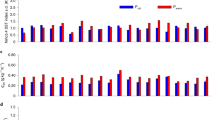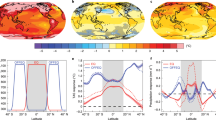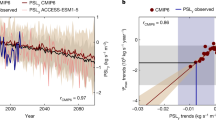Abstract
Under anthropogenic warming, deep-tropical ascent of the intertropical convergence zone (ITCZ) is projected to contract equatorward1,2,3 while subtropical descent associated with the Hadley cell edge is predicted to expand poleward4. These changes have important implications for regional climate2,5,6,7, but their mechanisms are not well understood. Here we reveal a key role of enhanced equatorial surface warming (EEW) in driving the deep-tropical contraction and modulating the Hadley expansion. By shifting the seasonally warmed sea surface temperature equatorward, EEW reduces the meridional migration of the seasonal ITCZ and causes an annual-mean deep-tropical contraction. This process further contracts the subtropical circulation, as seen during El Niño, and counteracts the Hadley expansion caused by the global-scale warming. The EEW-induced contraction even dominates in the Northern Hemisphere early summer (June–July), when atmospheric circulation responses to the global-scale warming are weak8. Regionally, this alters the East Asian summer monsoon, shifting both the subtropical jet and Meiyu–Baiu rainband equatorward. Among models in Phase 5 of the Coupled Model Intercomparison Project9, the degrees of the equatorward shift in the ITCZ, the early-summer subtropical circulation and the East Asian summer monsoon are correlated with EEW. Our results suggest that a better constraint on EEW is critical for accurate projection of tropical and subtropical climate change.
This is a preview of subscription content, access via your institution
Access options
Access Nature and 54 other Nature Portfolio journals
Get Nature+, our best-value online-access subscription
$29.99 / 30 days
cancel any time
Subscribe to this journal
Receive 12 print issues and online access
$209.00 per year
only $17.42 per issue
Buy this article
- Purchase on Springer Link
- Instant access to full article PDF
Prices may be subject to local taxes which are calculated during checkout




Similar content being viewed by others
Data availability
The data supporting the findings of this study are available within the manuscript and its supplementary information. Data associated with the GFDL-AM2.1 simulations are available at https://github.com/wenyuz/EEW. The AMIP and CMIP outputs can be obtained from the CMIP5 archive, accessed through http://www.ipcc-data.org/sim/gcm_monthly/AR5/Reference-Archive.html.
Code availability
The data analysis code is available from the corresponding author on request.
References
Huang, P., Xie, S.-P., Hu, K., Huang, G. & Huang, R. Patterns of the seasonal response of tropical rainfall to global warming. Nat. Geosci. 6, 357–361 (2013).
Lau, W. K. M. & Kim, K.-M. Robust Hadley circulation changes and increasing global dryness due to CO2 warming from CMIP5 model projections. Proc. Natl. Acad. Sci. USA 112, 3630–3635 (2015).
Byrne, M. P. & Schneider, T. Narrowing of the ITCZ in a warming climate: physical mechanisms. Geophys. Res. Lett. 43, 11350–11357 (2016).
Lu, J., Vecchi, G. A. & Reichler, T. Expansion of the Hadley cell under global warming. Geophys. Res. Lett. 34, L06805 (2007).
Scheff, J. & Frierson, D. M. W. Robust future precipitation declines in CMIP5 largely reflect the poleward expansion of model subtropical dry zones. Geophys. Res. Lett. 39, L18704 (2012).
Norris, J. R. et al. Evidence for climate change in the satellite cloud record. Nature 536, 72–75 (2016).
Kossin, J. P., Emanuel, K. A. & Vecchi, G. A. The poleward migration of the location of tropical cyclone maximum intensity. Nature 509, 349–352 (2014).
Shaw, T. A. & Voigt, A. Tug of war on summertime circulation between radiative forcing and sea surface warming. Nat. Geosci. 8, 560–566 (2015).
Taylor, K. E., Stouffer, R. J. & Meehl, G. A. An overview of CMIP5 and the experiment design. Bull. Am. Meteorol. Soc. 93, 485–498 (2012).
Neelin, J. D., Chou, C. & Su, H. Tropical drought regions in global warming and El Niño teleconnections. Geophys. Res. Lett. 30, 2275 (2003).
Byrne, M. P. & Schneider, T. Energetic constraints on the width of the intertropical convergence zone. J. Clim. 29, 4709–4721 (2016).
Byrne, M. P., Pendergrass, A. G., Rapp, A. D. & Wodzicki, K. R. Response of the intertropical convergence zone to climate change: location, width, and strength. Curr. Clim. Change Rep. 4, 355–370 (2018).
Held, I. M. The general circulation of the atmosphere. In Proc. 2000 Program of Study in Geophysical Fluid Dynamics 1–54 (Woods Hole Oceanographic Institution, 2000).
Walker, C. C. & Schneider, T. Eddy influences on Hadley circulations: simulations with an idealized GCM. J. Atmos. Sci. 63, 3333–3350 (2006).
Frierson, D. M. W., Lu, J. & Chen, G. Width of the Hadley cell in simple and comprehensive general circulation models. Geophys. Res. Lett. 34, L18804 (2007).
Liu, Z., Vavrus, S., He, F., Wen, N. & Zhong, Y. Rethinking tropical ocean response to global warming: the enhanced equatorial warming. J. Clim. 18, 4684–4700 (2005).
Vecchi, G. A. & Soden, B. J. Global warming and the weakening of the tropical circulation. J. Clim. 20, 4316–4340 (2007).
Dai, A. & Wigley, T. M. L. Global patterns of ENSO-induced precipitation. Geophys. Res. Lett. 27, 1283–1286 (2000).
Seager, R., Harnik, N., Kushnir, Y., Robinson, W. & Miller, J. Mechanisms of hemispherically symmetric climate variability. J. Clim. 16, 2960–2978 (2003).
Lu, J., Chen, G. & Frierson, D. M. W. Response of the zonal mean atmospheric circulation to El Niño versus global warming. J. Clim. 21, 5835–5851 (2008).
Donohoe, A., Atwood, A. R. & Byrne, M. P. Controls on the width of tropical precipitation and its contraction under global warming. Geophys. Res. Lett. https://doi.org/10.1029/2019GL082969 (2019).
Emanuel, K. A. On thermally direct circulations in moist atmospheres. J. Atmos. Sci. 52, 1529–1534 (1995).
Privé, N. C. & Plumb, R. A. Monsoon dynamics with interactive forcing. Part I: axisymmetric. Stud. J. Atmos. Sci. 64, 1417–1430 (2007).
Neelin, J. D. & Held, I. M. Modeling tropical convergence based on the moist static energy budget. Mon. Weather Rev. 115, 3–12 (1987).
Kang, S. M. & Lu, J. Expansion of the Hadley cell under global warming: winter versus summer. J. Clim. 25, 8387–8393 (2012).
Watt-Meyer, O. & Frierson, D. M. W. ITCZ width controls on Hadley cell extent and eddy-driven jet position and their response to warming. J. Clim. 32, 1151–1166 (2018).
Hilgenbrink, C. C. & Hartmann, D. L. The response of Hadley circulation extent to an idealized representation of poleward ocean heat transport in an aquaplanet GCM. J. Clim. 31, 9753–9770 (2018).
Chen, G., Plumb, R. A. & Lu, J. Sensitivities of zonal mean atmospheric circulation to SST warming in an aqua-planet model. Geophys. Res. Lett. 37, L12701 (2010).
Tandon, N. F., Gerber, E. P., Sobel, A. H. & Polvani, L. M. Understanding Hadley cell expansion versus contraction: insights from simplified models and implications for recent observations. J. Clim. 26, 4304–4321 (2012).
Sun, L., Chen, G. & Lu, J. Sensitivities and mechanisms of the zonal mean atmospheric circulation response to tropical warming. J. Atmos. Sci. 70, 2487–2504 (2013).
Sampe, T. & Xie, S.-P. Large-scale dynamics of the Meiyu-Baiu rainband: environmental forcing by the westerly jet. J. Clim. 23, 113–134 (2010).
Chen, J. & Bordoni, S. Orographic effects of the Tibetan Plateau on the East Asian summer monsoon: an energetic perspective. J. Clim. 27, 3052–3072 (2014).
Xie, S.-P. et al. Global warming pattern formation: sea surface temperature and rainfall. J. Clim. 23, 966–986 (2010).
Broccoli, A. J., Dahl, K. A. & Stouffer, R. J. Response of the ITCZ to Northern Hemisphere cooling. Geophys. Res. Lett. 33, L01702 (2006).
Kang, S. M., Held, I. M., Frierson, D. M. W. & Zhao, M. The response of the ITCZ to extratropical thermal forcing: idealized slab-ocean experiments with a GCM. J. Clim. 21, 3521–3532 (2008).
Schneider, T., Bischoff, T. & Haug, G. H. Migrations and dynamics of the intertropical convergence zone. Nature 513, 45–53 (2014).
GAMDT. The new GFDL global atmosphere and land model AM2–LM2: evaluation with prescribed SST simulations. J. Clim. 17, 4641–4673 (2004).
Dee, D. P. et al. The ERA-Interim reanalysis: configuration and performance of the data assimilation system. Q. J. R. Meteorol. Soc. 137, 553–597 (2011).
Bolton, D. The computation of equivalent potential temperature. Mon. Weather Rev. 108, 1046–1053 (1980).
Acknowledgements
This work is supported by the National Science Foundation (grant no. NSF-1637450) and Laboratory Directed Research and Development funding from Berkeley Lab, provided by the Director, Office of Science, of the US Department of Energy under contract no. DE-AC02-05CH11231. Numerical simulations were conducted using the computing resources provided by the NCAR Cheyenne: HPE/SGI ICE XA System (University Community Computing, https://doi.org/10.5065/D6RX99HX).
Author information
Authors and Affiliations
Contributions
W.Z. designed the research, conducted the simulations and analysed the results. S.-P.X. and D.Y. contributed to improving the analysis and interpretation. W.Z. wrote the first draft, and all authors discussed and edited the paper.
Corresponding author
Ethics declarations
Competing interests
The authors declare no competing interests.
Additional information
Peer review information Nature Climate Change thanks Michael Byrne and the other, anonymous, reviewer(s) for their contribution to the peer review of this work.
Publisher’s note Springer Nature remains neutral with regard to jurisdictional claims in published maps and institutional affiliations.
Supplementary information
Supplementary Information
Supplementary Figs. 1–11.
Rights and permissions
About this article
Cite this article
Zhou, W., Xie, SP. & Yang, D. Enhanced equatorial warming causes deep-tropical contraction and subtropical monsoon shift. Nat. Clim. Chang. 9, 834–839 (2019). https://doi.org/10.1038/s41558-019-0603-9
Received:
Accepted:
Published:
Issue Date:
DOI: https://doi.org/10.1038/s41558-019-0603-9
This article is cited by
-
Equatorward shift of the boreal summer intertropical convergence zone in Maritime Continent and the impacts on surface black carbon concentration and public health
npj Climate and Atmospheric Science (2024)
-
Seasonally varying SST changes in the joining area of Asia and Indian-Pacific Ocean from boreal spring to summer
Climate Dynamics (2024)
-
Greenhouse warming and internal variability increase extreme and central Pacific El Niño frequency since 1980
Nature Communications (2023)
-
Warming-induced contraction of tropical convection delays and reduces tropical cyclone formation
Nature Communications (2023)
-
A contracting Intertropical Convergence Zone during the Early Heinrich Stadial 1
Nature Communications (2023)



